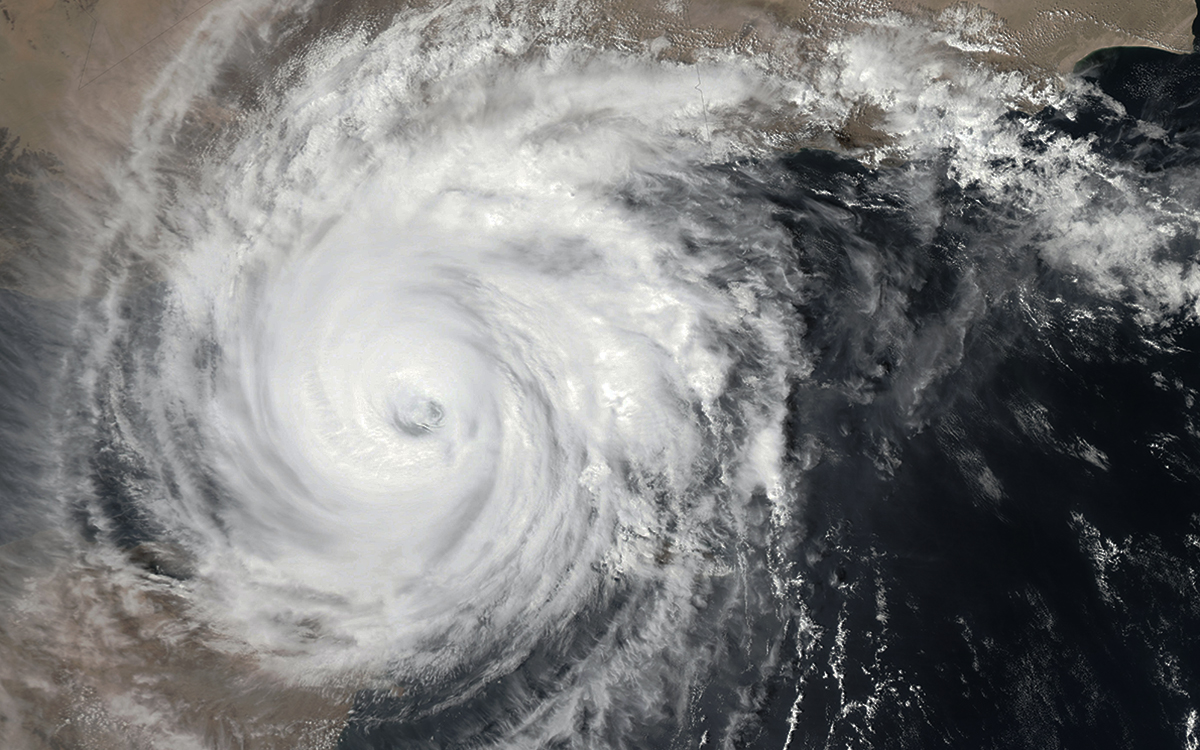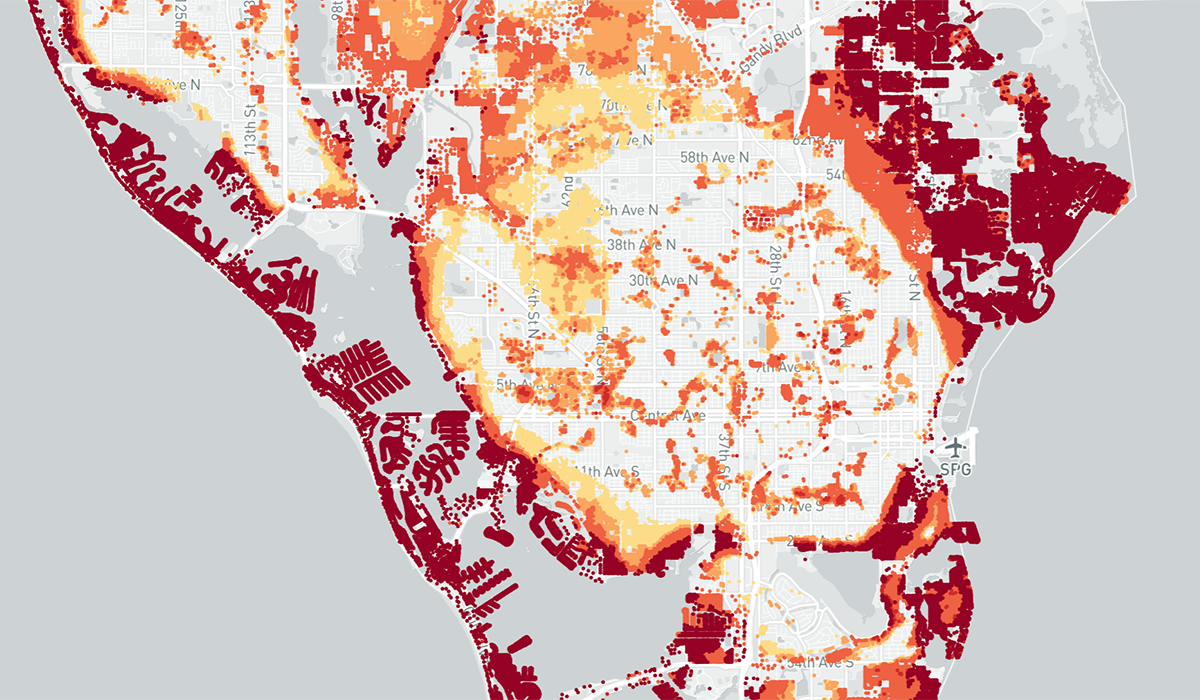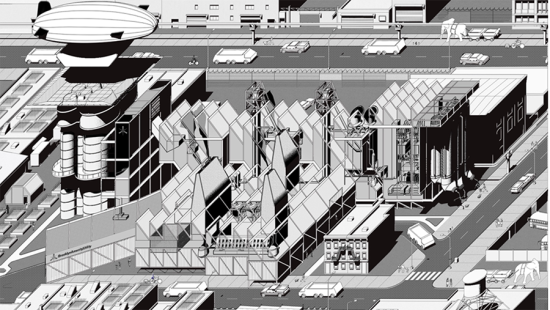Revealing Climate Change Inequities, Redress, and Environmental Justice
CRP Assistant Professor Linda Shi responds to three big questions about her timely research on populations vulnerable to climate change injustices and the planning discipline's critical contributions to the global discussion on adaptation and the future of cities.
 satellite image / NASA
satellite image / NASA
In response to increased climate disasters — tropical storms, sea-level rise, drought, wildfires, and other events — major climate adaptation projects around the world are producing inequitable land use plans and projects in urban regions, according to Linda Shi, Assistant Professor of City and Regional Planning. Shi is an urban environmental planner who has worked on international development and sustainability in the U.S., Asia, Latin America, and Africa. Combining various methods that use spatial mapping, field research, interviews, and quantitative data, Shi's research focuses on how the governance of societal climate adaptation impacts social equity and environmental sustainability. For example, one recent study shows how the diverging adaptation paths taken by the private sector, government, and civil society contributes to uncoordinated and socially unjust outcomes. Shi is a Senior Faculty Fellow at the Cornell Atkinson Center for Sustainability and this year received an $85,000 Cornell Migrations Initiative grant for her project Risk or Refuge: Inequality in Exposure to Environmental Vulnerability in California.
1
You have been working on the topic of climate change adaptation and inequity in urban planning for a decade and sharing your findings with other planners, policymakers, educators, and the general population. Briefly, what have we learned? Where are we now and where are we going?
We have learned that up to now, all our cities and ways of life have been built with the assumption that our environment is fairly stable and unchanging — from the built environment to infrastructure to the notion of how we relate to land. For example, property rights, our tax systems, and our insurance programs are all predicated on things not changing too much. Over time, cities located on coastlines and delta areas, wildland-urban interfaces, or mountains and steep slopes have significantly degraded environmentally sensitive areas. Roads, schools, and homes are built in places that will see disasters increasing in severity and frequency, sometimes multiple disasters with cascading impacts across different sectors of the economy, types of infrastructure, and types of existing natural hazards.
Now, we're finding it essential to adapt our infrastructure, cities, and ways of life to anticipate the changing climate. We have reached a point where millions of people worldwide are impacted by high heat, drought, wildfires, and other events — a number that trends suggest will continue to grow. For example, between 2015 and 2020, the U.S. experienced an average of 14 disasters per year at the cost of at least $1 billion, compared to just six and a half such events between 1980 and 2019. Also, $1 trillion of coastal real estate and 13 million people are currently threatened by rising sea levels, higher storm surges, and higher tidal flooding in the United States alone. Internationally, the vulnerabilities are even more severe. According to The World Bank, 143 million people across Africa, South Asia, and Latin America will be migrating within these regions by 2050 due to changing climate. This is the outlook at the moment.
As we develop adaptation plans, it is important to understand not only that climate change impacts communities unequally but also how cities' efforts to adapt to climate change can exacerbate existing inequalities. Beyond finding that these inequalities exist, planners and our adjacent disciplines are looking at how foundational institutions of land governance drive us toward these unequal outcomes and what kinds of reforms we're going to need to achieve more adapted, sustainable, and equitable outcomes.
 Detail of overall flood risks in St. Petersburg in Pinellas County, Florida. In the long term, climate gentrification and displacement may occur to communities of color and disadvantage currently living in higher elevation areas, forcing them into lower elevations that will become less desirable than they are now. image / FloodFactor
Detail of overall flood risks in St. Petersburg in Pinellas County, Florida. In the long term, climate gentrification and displacement may occur to communities of color and disadvantage currently living in higher elevation areas, forcing them into lower elevations that will become less desirable than they are now. image / FloodFactor
2
As the global concern of rising sea levels continues and has specific local consequences, your work finds commonalities across very different geographies, for example from Florida in the southern U.S. to South and Southeast Asia. What do these places share that can help us better understand the root causes of inequity and how we might work toward redress with more sustainable and equitable adaptation plans?
To better understand inequity and its causes, we need to be thinking collectively about climate change adaptation, not only to the environmental risks themselves, but why certain people are disproportionately vulnerable in the first place, and how societal adaption can become a process to redress those underlying drivers rather than surface risks.
As you might expect in the cases you mention, some of the common vulnerabilities are access to safe land, sufficient water, and adequate housing. In Florida, many cities on the coastline are heavily developed and have a lot of real estate lying within just a few feet of sea-level rise. What my students and I have found is that there is significant vulnerability to sea-level rise, but that that inequality is unequally spread along the coast. If we think about how people will migrate and places adapt, one can easily imagine that individuals or real estate firms will begin to invest in and buy up properties in those inland communities that are on higher ground, currently cheaper, and more diverse. As a result, we may see climate gentrification and displacement, where communities of color and disadvantage that are currently living in higher elevation areas that are relatively safer, end up being forced in the long term to move to those places that are lower and, in the future, less desirable and at higher risk than they are now.
But the underlying drivers here are things like individual property ownership that enable such displacement, the financialization of land use that drives municipalities to maximize development within their boundaries, and the fragmentation of land governance into 100 municipalities, on average, within each U.S. metro area. Even more fundamentally, they derive from a land ethics that treats land as severable property rather than a homeland for human and non-human species. We can, with some difficulty, move people and infrastructure around. But changing those underlying mindsets and institutions would actually transform society.
 Informal stilt houses along waterways like the Pasig River in Metro Manila are common when local governments allocate most land to middle- and upper-class housing subdivisions and malls. Denied housing in safe places, those living in informal settlements are the first to be evicted when adaptation projects widen drainage systems to make the rest of the city safer. photo / Linda Shi
Informal stilt houses along waterways like the Pasig River in Metro Manila are common when local governments allocate most land to middle- and upper-class housing subdivisions and malls. Denied housing in safe places, those living in informal settlements are the first to be evicted when adaptation projects widen drainage systems to make the rest of the city safer. photo / Linda Shi
In South and Southeast Asia, our research shows that consistently, a set of vulnerable people lose water and land rights as you follow the flow of water across the landscape. For example, cities expropriate farmers' water rights and they are forced to migrate from agricultural sectors to cities, often finding informal work, precarious housing, and less access to the very water taken from their homelands. Informal residents tend to be the first to be evicted when cities try to create urban water infrastructure to reduce flooding internally. They are resettled into peripheral urban areas where they lose out on opportunities for jobs and are not necessarily any safer from environmental risks. Moreover, cities' efforts to keep floodwaters out often push floodwaters into the periphery, where people in rural areas are disproportionately at risk.
Our research in these places and many others shows that we need more integrated and holistic ways of thinking about climate change across landscapes connecting different groups and the water and land resources they rely on. It also points to the opportunities for rural and urban solidarity and movement-building across groups that are often seen as politically, socially, and geographically divided.
"We want to make sure that the billions and trillions of dollars we spend on adaptation and the mass migration ahead will result in a society that is more beautiful, more sustainable, more equitable, and fairer than the one that we are trying to preserve and protect." Linda Shi, CRP; Cornell Atkinson Center for Sustainability
3
Your work connects people to planning to policy. Do you find there is general agreement on the necessity of new climate adaptation strategies to ensure a more just and sustainable future? Do you see a common path forward across scales and among people working in sectors with the greatest ability to effect change?
In the early days of climate adaptation, research, and practice, there was an assumption that if cities were adapting, then they must be progressive and doing good work. The research that my colleagues and I did was among the first to show that adaptation projects themselves can exacerbate existing inequalities as they roll out. In one project involving eight cases around the world, we showed how adaptation projects — sometimes called disaster risk reduction or infrastructure projects — ended up displacing low-income communities to make cities more resilient for those who could afford to live in them.
I don't know if there is agreement, but more and more people across sectors of society are attuned to the risks and impacts of climate change, and the opportunities this presents are both concerning and promising. For example, the private sector is beginning to consider climate impacts on assets and portfolios and to change systemic policies and codes and standards that will begin to shift and internalize climate costs. Their actions will have wide-ranging impacts across society but they're motivated by profitability and liability and not necessarily community well-being, social justice, and environmental sustainability. The internalization of these costs can begin to shift markets but can also leave behind communities that are unable to adapt, unable to move away, or unable to equalize adaptation across a metropolitan or environmental landscape.
With the Biden administration's re-entry into the global conversation, this is an exciting moment for climate change policy both on adaptation and mitigation. The administration immediately adopted an Executive Order in January that has led to a Justice 40 plan to spend federal funding so that 40% of benefits go to the disadvantaged communities most impacted by climate change. In May, Biden doubled FEMA's budget for helping communities with disaster preparedness, and in October over 20 federal agencies issued adaptation plans. These are big moves in the right direction, but while extra funding extends the time for communities to confront long-term climate impacts, they do not absolve us of having a national adaptation strategy that answers questions like: Where will people live in the U.S. under long-term climate change? Why do our development choices keep producing inequitable, racialized environments and in vulnerable places? How do we share our resources with the most vulnerable groups, including non-human species who must also adapt? To answer these deeper questions, we still have a long way to go.
Stay connected! Follow @cornellaap on instagram, facebook, twitter, and linkedIn; and subscribe to our AAP bi-weekly newsletter.






